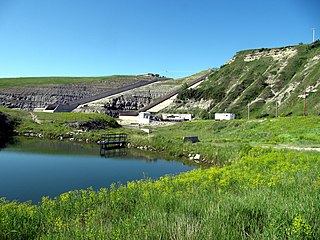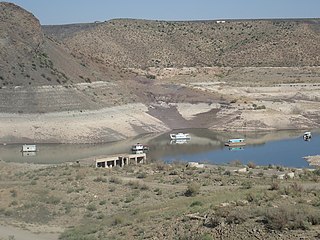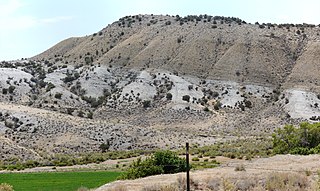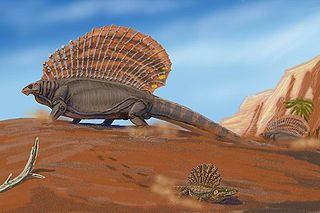| Bissett Formation | |
|---|---|
| Type | Geological formation |
| Lithology | |
| Primary | Conglomerate, non-marine limestone; sandstone |
| Location | |
| Region | Trans-Pecos, Texas |
| Country | United States of America |
| Type section | |
| Named by | P.B. King |
The Bissett Formation is a Mesozoic geologic formation. Dinosaur remains diagnostic to the genus level are among the fossils that have been recovered from the formation. [1]
The Bissett was first mapped and named by Philip B. King in 1927. King's stratigraphic reckoning described the Bissett as a Permian deposition.
E. C. Case changed the age determination in the 1930s to Triassic based on a photo of what he believed to be a fossil fragment of a desmatosuchus.
The Bissett comprises several types of sedimentary deposition, a conglomerate with Permian limestone cobbles, a sandstone sequence, red beds, and lacustrine limestone. It was in the limestone beds that fossil remains of the iguanadon were found (Wilcox, 1989)
The iguanadon remains were positively identified by Dr. Wann Langston at the University of Texas Bureau of Economic Geology Vertebrate Paleontology Lab in Austin. Other diagnostic fossils were also found during this effort in the same limestone outcrop, including conifers and bivalves.
The fossil discoveries positively place the age of the Bissett formation as early Cretaceous, approximately 115 million years ago.

The Purbeck Group is an Upper Jurassic to Lower Cretaceous lithostratigraphic group in south-east England. The name is derived from the district known as the Isle of Purbeck in Dorset where the strata are exposed in the cliffs west of Swanage.

The Laramie Formation is a geologic formation of Late Cretaceous (Maastrichtian) age, named by Clarence King in 1876 for exposures in northeastern Colorado, in the United States. It was deposited on a coastal plain and in coastal swamps that flanked the Western Interior Seaway. It contains coal, clay and uranium deposits, as well as plant and animal fossils, including dinosaur remains.
The Milk River Formation is a sandstone-dominated stratigraphic unit of the Western Canada Sedimentary Basin in southern Alberta, Canada. It was deposited in near-shore to coastal environments during Late Cretaceous time. Based on uranium-lead dating, palynology and stratigraphic relationships, deposition occurred between ~84.1 and 83.6 Ma.

The Wayan Formation is a geological formation in Idaho whose strata date back to the latest Early Cretaceous and the earliest Late Cretaceous. Dinosaur, other reptile, mammal, and micro and macro-floral remains are among the fossils that have been recovered from the formation. The lack of extensive outcrops, limited geographic extent, and extreme structural deformation have limited paleontological explorations of the Wayan.

The St. Mary River Formation is a geologic formation of Late Cretaceous age of the Western Canada Sedimentary Basin in southwestern Alberta and northwesternmost Montana. It was first described from outcrops along the St. Mary River by George Mercer Dawson in 1883, and it takes its name from the river.

The McRae Formation is a geological formation exposed in southern New Mexico whose strata date back to the Late Cretaceous. Dinosaur remains are among the fossils that have been recovered from the formation.

The Woodbine Group is a geological formation in east Texas whose strata date back to the Early to Middle Cenomanian age of the Late Cretaceous. It is the producing formation of the giant East Texas Oil Field from which over 5.42 billion barrels of oil have been produced. The Woodbine overlies the Maness Shale, Buda Limestone, or older rocks, and underlies the Eagle Ford Group or Austin Chalk. In outcrop the Woodbine Group has been subdivided into the Lewisville Sandstone, Dexter Sandstone, and/or Pepper Shale formations. Thin-bedded sands of the Woodbine and Eagle Ford are collectively referred to as the "Eaglebine" oil and gas play in the southwestern portion of the East Texas region.
The El Picacho Formation is a geological formation in Texas, United States, whose strata date back to the Late Cretaceous. Dinosaur remains are among the fossils that have been recovered from the formation. The paleosols found here are rich in clay, calcite, and rhizoliths which show that during the Cretaceous period, this fossil formation, just like the neighboring Javelina Formation and Aguja Formation, was a fluvial flood plain.

The Austin Chalk is an upper Cretaceous geologic formation in the Gulf Coast region of the United States. It is named after type section outcrops near Austin, Texas. The formation is made up of chalk and marl.
The Futaba Group is a Late Cretaceous geologic group in Japan. Dinosaur remains are among the fossils that have been recovered from the formation, although none have yet been referred to a specific genus. It consists of both fluvial and shallow marine sediments. The plesiosaur Futabasaurus was found in this unit.
The Ringbone Formation is a Campanian geologic formation in southwestern New Mexico.
The Hampen Formation is a Jurassic geological formation of Bathonian age found in central Southern England. Dinosaur remains diagnostic to the genus level are among the fossils that have been recovered from the formation. This formation was formerly known as the Hamden Marly Formation or the Hamden Marly Beds.
The Korycanar Formation is a Late Cretaceous geologic formation in the Czech Republic. Archosauromorph remains diagnostic to the genus level are among the fossils that have been recovered from the formation and also dinosaur remains are among the fossils that have been recovered from the formation, although none have yet been referred to a specific genus.
The Marshalltown Formation is a Mesozoic geologic formation. Dinosaur remains diagnostic to the genus level are among the fossils that have been recovered from the formation.
The Moreno Formation is a Mesozoic geologic formation located in San Joaquin Valley (California).
Dinosaur remains diagnostic to the genus level are among the fossils that have been recovered from the formation.

The Mowry Shale is an Early Cretaceous geologic formation. The formation was named for Mowrie Creek, northwest of Buffalo in Johnson County, Wyoming.
The Severn Formation is a Mesozoic geologic formation in Maryland. Dinosaur remains diagnostic to the genus level are among the fossils that have been recovered from the formation.

The Red Beds of Texas and Oklahoma are a group of Early Permian-age geologic strata in the southwestern United States cropping out in north-central Texas and south-central Oklahoma. They comprise several stratigraphic groups including the Clear Fork Group, the Wichita Group, and the Pease River Group. The Red Beds were first explored by American paleontologist Edward Drinker Cope starting in 1877. Fossil remains of many Permian tetrapods have been found in the Red Beds, including those of Dimetrodon, Edaphosaurus, Seymouria, Platyhystrix, and Eryops. A recurring feature in many of these animals is the sail structure on their backs.
The prehistory of the United States comprises the occurrences within regions now part of the United States during the interval of time spanning from the formation of the Earth to the documentation of local history in written form. At the start of the Paleozoic era, what is now "North" America was actually in the southern hemisphere. Marine life flourished in the country's many seas, although terrestrial life had not yet evolved. During the latter part of the Paleozoic, seas were largely replaced by swamps home to amphibians and early reptiles. When the continents had assembled into Pangaea drier conditions prevailed. The evolutionary precursors to mammals dominated the country until a mass extinction event ended their reign.

The Greenhorn Limestone or Greenhorn Formation is a geologic formation in the Great Plains Region of the United States, dating to the Cenomanian and Turonian ages of the Late Cretaceous period. The formation gives its name to the Greenhorn cycle of the Western Interior Seaway.
Wilcox, Robert E.: Evidence for an Early Cretaceous Age for the Bissett Formation, Western Glass Mountains, Brewster and Pecos Counties, West Texas: Implications for Regional Stratigraphy, Paleogeography, and Tectonics; Sul Ross State University; 1989.